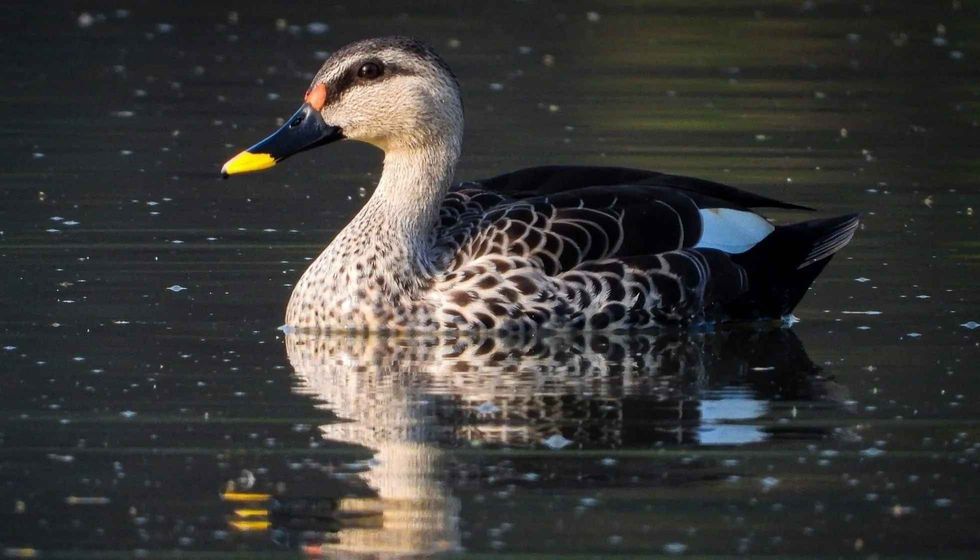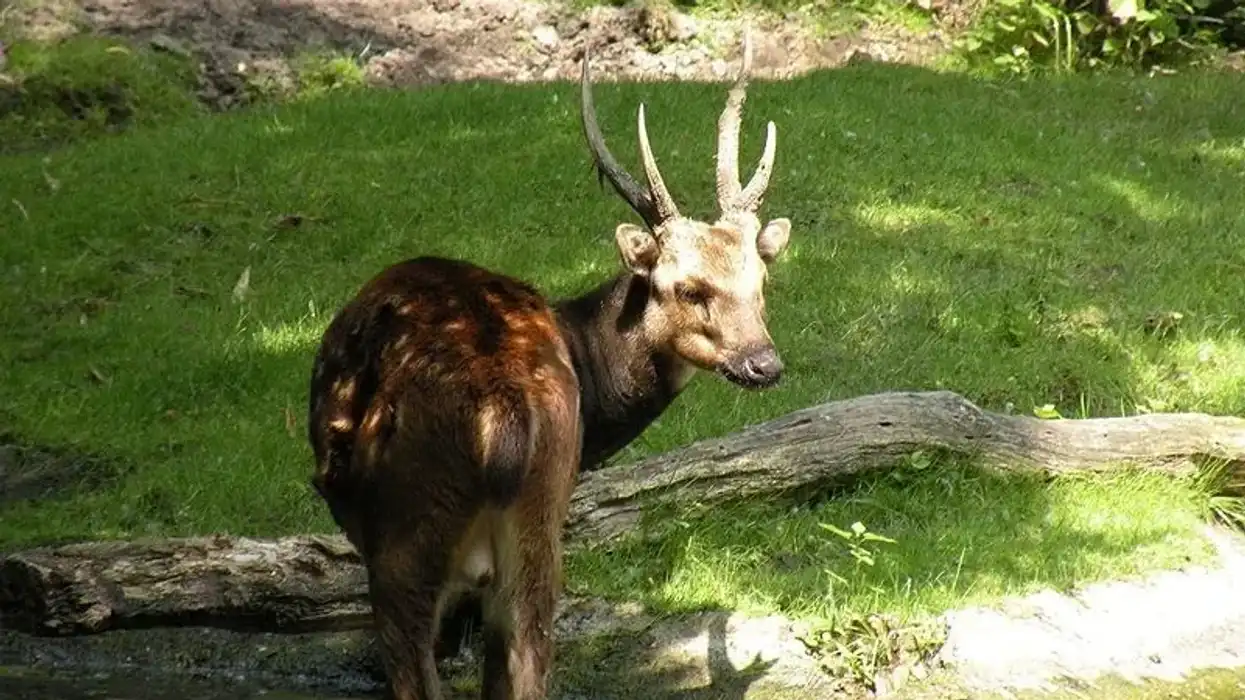The Indian spot-billed duck (Anas poecilorhyncha), is one of the two kinds of spot-billed ducks, and also known as the spotbill or the Indian spotbill.
It is commonly found across the Indian subcontinent in freshwater lakes and marshes that have plenty of vegetation. This duck is one of the most easily recognizable birds in the world because of the yellow spot present on the tip and the red spot on the base of its bill.
Its feathers make a scaly pattern and there are bright white feathers on its wings.
Even when in flight, it can be spotted by its iridescent green speculum.
It has many characteristics in common with the mallard and is a sister species of the Eastern spot-billed duck (Anas zonorhyncha) that is found in Chinese wetlands but it does not bear the red spot on the base of its bill and has a blue speculum instead of a green one.
These colorful birds are dabbling ducks, which means that they usually stay to the surface instead of diving down into the water to feed.
If you want to know more about more interesting facts about ducks, check out our Fulvous whistling duck facts and American black duck facts.
Indian Spot-Billed Duck Interesting Facts
What type of animal is an Indian Spot-billed Duck?
The Indian spot-billed duck is a type of duck.
What class of animal does an Indian Spot-billed Duck belong to?
It is a bird belonging to the Anatidae family with the scientific name Anas poecilorhyncha which is derived from the Latin and Greek words meaning 'duck', 'spotted', and 'bill'.
How many Indian Spot-billed Ducks are there in the world?
The exact population of the spot-billed duck in the world is unknown but is estimated to be around 150,000-1,100,000.
Where does an Indian Spot-billed Duck live?
The Indian spot-billed duck (Anas poecilorhyncha) is mostly found in the wetlands of India, Nepal, and Pakistan. They are not migrating birds but may move locally in search of food and water.
What is an Indian Spot-billed Duck's habitat?
This species is known to prefer wetlands such as lakes, ponds, marshes, and streams with enough vegetation around for them to feed and lay eggs on.
Who do Indian Spot-billed Ducks live with?
This species is highly partial to living alone, in pairs or small groups, and does not like to be disturbed in its natural habitat as they swim or fly away when bothered.
How long does an Indian Spot-billed Duck live?
The average lifespan of these birds is unknown.
How do they reproduce?
This species of bird breeds in the rainy season. The number of eggs they lay ranges from 8-14 eggs in a nest that they build on land or in a tree in such a manner that it is hidden in the vegetation from any danger.
The eggs hatch about 24 days later and reveal chicks that are black with a yellow stripe.
The chicks that are born look quite similar to mallard chicks. After the breeding is complete, both the male and female bird shed all their feathers in a process that is called post-breeding molting.
What is their conservation status?
Their distribution in the world is large enough to have been classified as Least Concern by the IUCN.
Indian Spot-Billed Duck Fun Facts
What do Indian Spot-billed Ducks look like?
Indian spot-billed ducks are brownish-gray in color and are largely characterized by the red spot on the base and the yellow spot on the tip of their black bill. However, the red spot on the base of the bill may not be present in the females of this species, who are also browner than their male counterparts.
Their feet are bright orange and they have a bright green iridescent speculum bordered by white that can be seen when they are flying.
How cute are they?
From their colorful bill to their alluring scaly feathers, they are a beautiful species that would rather be alone than in your company, which makes them somewhat cute but only from afar.
How do they communicate?
These birds have a loud quack, that sounds similar to the call of a mallard, so they likely make that sound to communicate with their fellow ducks or ducklings.
How big is an Indian Spot-billed Duck?
This species of bird is 22-25 in (55-63 cm) in length and is 33–37 in (83–95 cm) when it spreads its wings. It is around the same size as the Eastern spot-billed duck (Anas zonorhyncha) and a mallard but a little bigger than a Harlequin duck.
How fast can an Indian Spot-billed Duck fly?
The exact speed with which this species flies is not known but they have been witnessed flying fairly quickly by some people.
How much does an Indian Spot-billed Duck weigh?
The males of Anas poecilorhyncha weigh about 2.6-3.3 lb (1200-1500 g) while the females weigh 1.7-3 lb (800-1350 g), which makes them weigh a little less than crested ducks.
What are the male and female names of the species?
There are no specific names for the male and females of this species.
What would you call a baby Indian Spot-billed Duck?
A baby Indian spot-billed duck is called a chick or a duckling. They are referred to as juveniles when they start to grow a little more.
What do they eat?
These ducks mostly consume wild, aquatic plants, grasses, and crops such as rice but will also occasionally feed on insects, worms, or snails.
They might also be eaten by pythons if they are generally found within the same area.
Are they dangerous?
This bird is not dangerous but it should not be disturbed if seen in its natural habitat as it prefers to be alone or in a small group of its fellow ducks.
Would they make a good pet?
Seeing that they do not like to be bothered by anyone in the wild, there is a good chance that they would not make a good pet.
Did you know...
Indian spot-billed ducks only eat in the evening or night by up-ending themselves on the surface of the water to feed on aquatic plants.
Different types of Spot-billed Duck
There are two types of spot-billed ducks: the Indian spot bill, Anas poecilorhyncha, which is found in the Indian subcontinent, and the Eastern spot-billed duck, Anas zonorhyncha, which is found in East and Southeast Asian Countries.
The Chinese spotbill was formerly considered as a subspecies of the Indian spotbill but after further research, they are now both considered as separate species.
Do Indian Spot-billed Ducks dive?
Since they are dabbling ducks, they don't usually dive down into the water. However, if in danger, they might dive below the surface of the water and hide there till they feel safe to come back up.
This skill of theirs would have been useful to them in British India when they were hunted to quite an extent for their taste.
Here at Kidadl, we have carefully created lots of interesting family-friendly animal facts for everyone to discover! Learn more about some other birds from our Muscovy ducks facts and kingfishers facts pages.
You can even occupy yourself at home by coloring in one of our free printable Indian spot-billed duck coloring pages.










